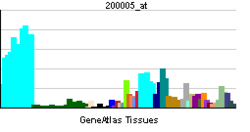EIF3D
| View/Edit Human | View/Edit Mouse |
Eukaryotic translation initiation factor 3 subunit D is a protein that in humans is encoded by the EIF3D gene.[3][4]
Function
Eukaryotic translation initiation factor-3 (eIF3), the largest of the eIFs, is a multiprotein complex composed of at least ten nonidentical subunits. The complex binds to the 40S ribosome and helps maintain the 40S and 60S ribosomal subunits in a dissociated state. It is also thought to play a role in the formation of the 40S initiation complex by interacting with the ternary complex of eIF2/GTP/methionyl-tRNA, and by promoting mRNA binding. The protein encoded by this gene is the major RNA binding subunit of the eIF3 complex.[4]
Interactions
EIF3D has been shown to interact with PHLDA1[5] and EIF3A.[6][7][8]
See also
References
- ↑ "Human PubMed Reference:".
- ↑ "Mouse PubMed Reference:".
- ↑ Asano K, Vornlocher HP, Richter-Cook NJ, Merrick WC, Hinnebusch AG, Hershey JW (Nov 1997). "Structure of cDNAs encoding human eukaryotic initiation factor 3 subunits. Possible roles in RNA binding and macromolecular assembly". J. Biol. Chem. 272 (43): 27042–52. doi:10.1074/jbc.272.43.27042. PMID 9341143.
- 1 2 "Entrez Gene: EIF3S7 eukaryotic translation initiation factor 3, subunit 7 zeta, 66/67kDa".
- ↑ Hinz T, Flindt S, Marx A, Janssen O, Kabelitz D (May 2001). "Inhibition of protein synthesis by the T cell receptor-inducible human TDAG51 gene product". Cell. Signal. 13 (5): 345–52. doi:10.1016/S0898-6568(01)00141-3. PMID 11369516.
- ↑ Ewing RM, Chu P, Elisma F, Li H, Taylor P, Climie S, McBroom-Cerajewski L, Robinson MD, O'Connor L, Li M, Taylor R, Dharsee M, Ho Y, Heilbut A, Moore L, Zhang S, Ornatsky O, Bukhman YV, Ethier M, Sheng Y, Vasilescu J, Abu-Farha M, Lambert JP, Duewel HS, Stewart II, Kuehl B, Hogue K, Colwill K, Gladwish K, Muskat B, Kinach R, Adams SL, Moran MF, Morin GB, Topaloglou T, Figeys D (2007). "Large-scale mapping of human protein-protein interactions by mass spectrometry". Mol. Syst. Biol. 3 (1): 89. doi:10.1038/msb4100134. PMC 1847948
 . PMID 17353931.
. PMID 17353931. - ↑ Mayeur GL, Fraser CS, Peiretti F, Block KL, Hershey JW (Oct 2003). "Characterization of eIF3k: a newly discovered subunit of mammalian translation initiation factor elF3". Eur. J. Biochem. 270 (20): 4133–9. doi:10.1046/j.1432-1033.2003.03807.x. PMID 14519125.
- ↑ Block KL, Vornlocher HP, Hershey JW (Nov 1998). "Characterization of cDNAs encoding the p44 and p35 subunits of human translation initiation factor eIF3". J. Biol. Chem. 273 (48): 31901–8. doi:10.1074/jbc.273.48.31901. PMID 9822659.
Further reading
- Asano K, Kinzy TG, Merrick WC, Hershey JW (1997). "Conservation and diversity of eukaryotic translation initiation factor eIF3". J. Biol. Chem. 272 (2): 1101–9. doi:10.1074/jbc.272.2.1101. PMID 8995409.
- Méthot N, Rom E, Olsen H, Sonenberg N (1997). "The human homologue of the yeast Prt1 protein is an integral part of the eukaryotic initiation factor 3 complex and interacts with p170". J. Biol. Chem. 272 (2): 1110–6. doi:10.1074/jbc.272.2.1110. PMID 8995410.
- Block KL, Vornlocher HP, Hershey JW (1998). "Characterization of cDNAs encoding the p44 and p35 subunits of human translation initiation factor eIF3". J. Biol. Chem. 273 (48): 31901–8. doi:10.1074/jbc.273.48.31901. PMID 9822659.
- Dunham I, Shimizu N, Roe BA, Chissoe S, Hunt AR, Collins JE, Bruskiewich R, Beare DM, Clamp M, Smink LJ, Ainscough R, Almeida JP, Babbage A, Bagguley C, Bailey J, Barlow K, Bates KN, Beasley O, Bird CP, Blakey S, Bridgeman AM, Buck D, Burgess J, Burrill WD, O'Brien KP (1999). "The DNA sequence of human chromosome 22". Nature. 402 (6761): 489–95. doi:10.1038/990031. PMID 10591208.
- Asano K, Shalev A, Phan L, Nielsen K, Clayton J, Valásek L, Donahue TF, Hinnebusch AG (2001). "Multiple roles for the C-terminal domain of eIF5 in translation initiation complex assembly and GTPase activation". EMBO J. 20 (9): 2326–37. doi:10.1093/emboj/20.9.2326. PMC 125443
 . PMID 11331597.
. PMID 11331597. - Hinz T, Flindt S, Marx A, Janssen O, Kabelitz D (2001). "Inhibition of protein synthesis by the T cell receptor-inducible human TDAG51 gene product". Cell. Signal. 13 (5): 345–52. doi:10.1016/S0898-6568(01)00141-3. PMID 11369516.
- Morris-Desbois C, Réty S, Ferro M, Garin J, Jalinot P (2001). "The human protein HSPC021 interacts with Int-6 and is associated with eukaryotic translation initiation factor 3". J. Biol. Chem. 276 (49): 45988–95. doi:10.1074/jbc.M104966200. PMID 11590142.
- Mayeur GL, Fraser CS, Peiretti F, Block KL, Hershey JW (2003). "Characterization of eIF3k: a newly discovered subunit of mammalian translation initiation factor elF3". Eur. J. Biochem. 270 (20): 4133–9. doi:10.1046/j.1432-1033.2003.03807.x. PMID 14519125.
- Collins JE, Wright CL, Edwards CA, Davis MP, Grinham JA, Cole CG, Goward ME, Aguado B, Mallya M, Mokrab Y, Huckle EJ, Beare DM, Dunham I (2004). "A genome annotation-driven approach to cloning the human ORFeome". Genome Biol. 5 (10): R84. doi:10.1186/gb-2004-5-10-r84. PMC 545604
 . PMID 15461802.
. PMID 15461802. - Rush J, Moritz A, Lee KA, Guo A, Goss VL, Spek EJ, Zhang H, Zha XM, Polakiewicz RD, Comb MJ (2005). "Immunoaffinity profiling of tyrosine phosphorylation in cancer cells". Nat. Biotechnol. 23 (1): 94–101. doi:10.1038/nbt1046. PMID 15592455.
- Ewing RM, Chu P, Elisma F, Li H, Taylor P, Climie S, McBroom-Cerajewski L, Robinson MD, O'Connor L, Li M, Taylor R, Dharsee M, Ho Y, Heilbut A, Moore L, Zhang S, Ornatsky O, Bukhman YV, Ethier M, Sheng Y, Vasilescu J, Abu-Farha M, Lambert JP, Duewel HS, Stewart II, Kuehl B, Hogue K, Colwill K, Gladwish K, Muskat B, Kinach R, Adams SL, Moran MF, Morin GB, Topaloglou T, Figeys D (2007). "Large-scale mapping of human protein-protein interactions by mass spectrometry". Mol. Syst. Biol. 3 (1): 89. doi:10.1038/msb4100134. PMC 1847948
 . PMID 17353931.
. PMID 17353931.
This article is issued from Wikipedia - version of the 5/20/2016. The text is available under the Creative Commons Attribution/Share Alike but additional terms may apply for the media files.
